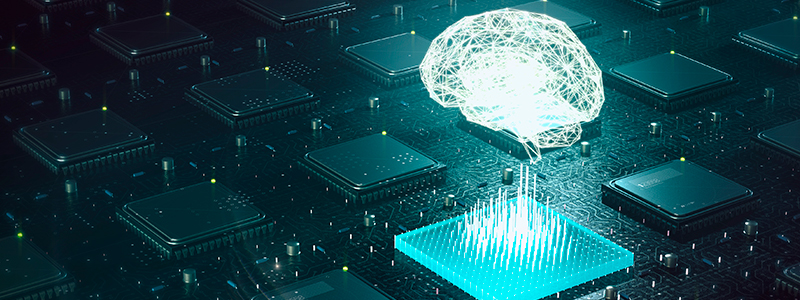What is machine learning?
Posted on: July 20, 2021by Ruth Brooks

Though machine learning seems like a relatively new concept, the term ‘machine learning’ was actually first coined in 1959 by Arthur Samuel during his research on teaching a computer how to play the game of checkers.
Since this seminal work on artificial intelligence (AI), machine learning has evolved greatly over the last few decades.
What is machine learning?
Machine learning is a branch of AI. While AI is the science of mimicking human actions and behaviour, machine learning is a science which trains a machine how to learn.
Machine learning algorithms work by finding patterns in large amounts of data. The data can be a range of formats – numbers, words, images, clicks, or anything that can be digitally stored and fed into a machine learning algorithm. The algorithms are then trained to make classifications or predictions and uncover key insights with data mining projects.
Though machine learning models were first created decades ago, the ability for these algorithms to automatically apply complex mathematical calculations to big data quickly is a relatively recent development, and many companies now are using machine learning for a number of different uses.
As the prevalence of big data continues to rise, market demand for data science specialists will expand too, as businesses increasingly use machine learning to impact their success and growth.
What is deep learning?
Deep learning is a subfield of machine learning. While machine learning largely depends on human intervention to learn and humans determine the differences between features in data points, deep learning automates much of the feature extraction part of the process, eliminating the need for human intervention and enabling the use of large datasets.
Deep learning can process large batches of unstructured data and can automatically determine features which distinguish different categories of data from one another.
To go even further, neural networks is a subfield of deep learning. Sometimes known as artificial neural networks (ANNs), these are made up of different node layers – an input layer, an output layer, and one or more hidden layers. Vaguely inspired by the inner workings of the human brain, nodes are like neurons and the network is like the brain.
Each node is connected, and if one goes over the threshold of its associated weight, the node is activated and data is sent to the next layer. A neural network consisting of more than three layers can be considered a deep learning algorithm.
It is deep learning and neural networks which are credited with causing progress in areas such as computer vision, natural language processing, and speech recognition.
How does machine learning work?
Most machine learning algorithms consist of three components. These are:
- A decision process – where the algorithm will produce an estimate about a pattern in the data
- An error function – measuring how accurate the estimation was by comparing it to known examples where available
- An updating or optimising process – where the algorithm assesses the miss and circles back to update the decision process to refine the estimation to make it more accurate
Machine learning methods
There are multiple types of machine learning, these include:
Supervised learning
In supervised machine learning, labeled data tells the machine what patterns to look for. This type of machine learning enables algorithms to be trained to classify or predict outcomes in new data accurately. Some methods used in supervised learning include neural networks, linear regression, logistic regression, support vector machines, and more.
Unsupervised learning
Unsupervised machine learning uses unlabeled datasets for algorithms to analyse. Algorithms discover hidden patterns and data groupings without human intervention, or without being trained or told what to look for.
Semi-supervised learning
Semi-supervised learning involves a combination of both labeled and unlabeled datasets. As labeled data can be time consuming to create or expensive to sort, a small amount of labeled data is used to guide classification and feature extraction from a larger dataset of unlabeled data.
Reinforcement learning
Reinforcement machine learning is when a machine learning model learns by trial and error, with successful outcomes reinforced through rewards. One example of reinforcement learning is when IBM’s Gerry Tesauro used it to build a self-learning backgammon player in 1992.
Where is machine learning used?
Machine learning is used in many businesses across multiple industries, both in day-to-day applications that we interact with, perhaps without realising, and in machine learning projects that are aiming to change the world.
One project which has been much talked about is the Google self-driving car. This is being created using machine learning.
Regular users of Amazon or Netflix will have noticed both platforms suggesting recommendations for new products or new TV shows to watch. These recommendations are also created using machine learning.
Other day-to-day instances include the filtering of certain emails into our spam folders, fraud detection on our bank accounts, or chatbots on many websites. Even job sites like LinkedIn use machine learning to analyse what our next role might be.
Machine learning isn’t restricted to just one industry, as many can and do implement it to grow their businesses or to make their customer experience better or safer. Financial services use it to prevent fraud and use data mining to identify high-risk profiles, government agencies use it to increase efficiency and save money, and healthcare uses it to assess a patient’s health in real-time. Machine learning is also used in transportation to make routes more efficient, and retail to give you a personalised shopping experience.
How to learn machine learning
Machine learning is a rapidly expanding field, and more and more businesses are in need of data scientists to help them scale their use of this innovative and lucrative tool. The IT skills gap is global and vast, so there has never been a better time to develop your knowledge of machine learning and be in high demand in this well paid sector.
On our MSc Computer Science, our machine learning module will give you hands-on experience of how to apply techniques and solve engineering case studies.
This degree is studied completely online and part-time, so you can continue to develop your career as you fit your learning around your life.





